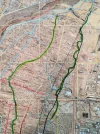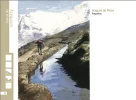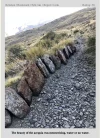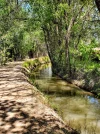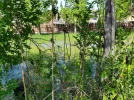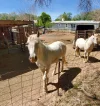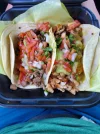- Time of past OR future Camino
- CF in spring and winter, Portugues, Sanabres: 2024
April 24, 2020
Today I riffed on the historical connections between Spain and New Mexico in all sorts of ways. Most of the day I hiked along one of the oldest acequias (water ditches) in Albuquerque, right next to the original, ancient route of the Camino Real; now Edith Blvd. NW
El Camino Real de Tierra Adentro (Royal Road of the Interior Land), was a 1600 mile trade route between Mexico City and Ohkay Owingeh pueblo north of Santa Fe, from 1598 – 1882. Up and down this route traveled Spanish, Mexican and American explorers, settlers, soldiers and missionaries. For a thousand or more years before that, indigenous people from what is now southern Mexico walked this same route, trading products such as turquoise, obsidian, salt and parrot feathers with northern tribes by the Rocky Mountains.
The rural, curvy section of north Edith Blvd. sits directly on this ancient path.
The Pueblo people of New Mexico revolted in 1680, killing 400 Spaniards and driving the remaining 2000 settlers out of the province, back down into what is now Mexico. Twelve years later, the Spanish reconquered the area and began to settle the Rio Grande valley in earnest (the amazing story is a lot longer than that, obviously).
One of the first things the Spanish settlers did was to dig agricultural ditches, “acequias” to channel water all through the Rio Grande valley to water their crops. Some of the oldest ditches here had already been built before the Spanish got here by indigenous people to water their crops, too. I believe the section of ditch I walked today pre-dates Spanish arrival, because of how it weaves around.
And today, the acequia was still doing its job; full of water, with gates channeling it into small pastures and farmlands.
The old acequias – from before the Anglos arrived – took advantage of physical features of the land (and gravity), so they were much curvier than the ones built much later in the 1920s-1940s.
If you go to Google Maps and type in the coordinates: 35.195865, -106.603873, switch to satellite view, you can see the acequia I walked today. (the photos are from winter when it was dry and brown. Much greener right now). I started about two miles south of this point and walked until I got to the border of the Sandia Pueblo reservation border. I passed just below Vara Wines, whose name honors Spanish history connected to the Camino Real. I’ll talk more about them later. You can find Vara Wines here, just off Alameda and see the acequia I walked below, to the west: 35.187222, -106.604488
In the middle of a city of 915,000 people, I met one other person walking on the trail with her dog. And a few on horseback. Plenty of “social distancing,” and in many places it easily could have been 200 years ago. There were fruit orchards and alfalfa pastures, burros and sheep, huge old cottonwood trees, ducks, lizards, flowers, many quaint adobe haciendas built around the turn of the century and a spectacular view of the Sandia mountains.
I stopped to talk to an older lady working in her backyard. She told me that her family since before her grandparents have lived on this land. Her name was Chavez and she told me, “these are all old families along here. Most of them on either side of the road right by here are named Chavez, but none of us are related.” I asked if she knew that she lived right on the Camino Real that had been used since the late 1500s. She said, “Oh yes! There are lots of very old places here. That house across the way was built in 1912.”
After my walk, I was famished, so I stopped at Federiquito’s on 4th St. for tacos. (It used to be Federico’s, but it closed and now it’s run by the little Federicos, I guess). These were real Mexican style tacos, not New Mexican style. Soft corn tortillas filled with grilled meat, pico de gallo red salsa and green tomatillo sauce. My sister-in-law from northern Spain was appalled to see, on some of the Mexican restaurant signs here, “Spanish Food.” We can thank the indigenous people of our region for our Mexican and New Mexican food. “Tortillas” in Spain are egg and potato omelets. You don't find much corn and hot salsa in Spanish food.
After getting home and resting my feet, I headed back up to Vara Wines to pick up our take-out paella, which they make in a big traditional pan every Friday (sadly, just take-out for the time being). This was REAL Spanish food, with saffron-infused rice, chorizo, chicken, mussels and shrimp. I highly recommend it.
Vara imports Spanish wines and also makes wine from local grapes in the Spanish style. “Vara” means “cane” in Spanish. They named the winery after the engraved canes historically presented to local tribes to acknowledge their sovereignty. The first was in 1620, an engraved cane presented to the Indian Pueblos in the Province of New Mexico by King Philip III of Spain (well before the Pueblo revolt). In 1863, President Abraham Lincoln issued engraved canes to each of the 19 pueblos as recognition of their property ownership and right to self-governance. Today these canes are still revered by the Pueblo people as physical and living reminders of their Pueblos’ natural authority. I believe Isleta Pueblo has the cane from 1620, but I’m not sure.
From Vara’s site: “In 1629, a Franciscan friar named García de Zúñiga and a Capuchin monk named Antonio de Arteaga planted the first European wine grapes in what is now the U.S. at a pueblo in the Rio Grande Valley of the Province of New Mexico (or Nuevo Espana). Viticulture took hold in the valley, and by the year 1880 the New Mexico territory was the fifth largest wine producer in America. The cuttings brought to the new world by missionaries from Spain were of a Vitis Vinifera grape variety known as Listan Prieto; the present day Mission grape. This variety has been continuously grown and is still harvested in New Mexico today.” Vara makes a local wine from this very grape called Vina Cardinal. You can see Doug talking about this history here: https://nmliving.com/…/vara-winery-distillery-doesnt-have-…/
When I told him, Doug acted like he already knew the winery sits just above the original Camino Real where monks carried their wines north through the territory four centuries ago. Maybe he did or maybe he didn’t, but I know he does now.
Full of tacos, paella, and wine, I flopped on the couch and read my book, a wonderful novel by Isabel Allende from Chile that takes place during the Spanish Civil War, "A Long Petal of the Sea."
In the picture below, the acequia I walked is in dark green on the right.
Today I riffed on the historical connections between Spain and New Mexico in all sorts of ways. Most of the day I hiked along one of the oldest acequias (water ditches) in Albuquerque, right next to the original, ancient route of the Camino Real; now Edith Blvd. NW
El Camino Real de Tierra Adentro (Royal Road of the Interior Land), was a 1600 mile trade route between Mexico City and Ohkay Owingeh pueblo north of Santa Fe, from 1598 – 1882. Up and down this route traveled Spanish, Mexican and American explorers, settlers, soldiers and missionaries. For a thousand or more years before that, indigenous people from what is now southern Mexico walked this same route, trading products such as turquoise, obsidian, salt and parrot feathers with northern tribes by the Rocky Mountains.
The rural, curvy section of north Edith Blvd. sits directly on this ancient path.
The Pueblo people of New Mexico revolted in 1680, killing 400 Spaniards and driving the remaining 2000 settlers out of the province, back down into what is now Mexico. Twelve years later, the Spanish reconquered the area and began to settle the Rio Grande valley in earnest (the amazing story is a lot longer than that, obviously).
One of the first things the Spanish settlers did was to dig agricultural ditches, “acequias” to channel water all through the Rio Grande valley to water their crops. Some of the oldest ditches here had already been built before the Spanish got here by indigenous people to water their crops, too. I believe the section of ditch I walked today pre-dates Spanish arrival, because of how it weaves around.
And today, the acequia was still doing its job; full of water, with gates channeling it into small pastures and farmlands.
The old acequias – from before the Anglos arrived – took advantage of physical features of the land (and gravity), so they were much curvier than the ones built much later in the 1920s-1940s.
If you go to Google Maps and type in the coordinates: 35.195865, -106.603873, switch to satellite view, you can see the acequia I walked today. (the photos are from winter when it was dry and brown. Much greener right now). I started about two miles south of this point and walked until I got to the border of the Sandia Pueblo reservation border. I passed just below Vara Wines, whose name honors Spanish history connected to the Camino Real. I’ll talk more about them later. You can find Vara Wines here, just off Alameda and see the acequia I walked below, to the west: 35.187222, -106.604488
In the middle of a city of 915,000 people, I met one other person walking on the trail with her dog. And a few on horseback. Plenty of “social distancing,” and in many places it easily could have been 200 years ago. There were fruit orchards and alfalfa pastures, burros and sheep, huge old cottonwood trees, ducks, lizards, flowers, many quaint adobe haciendas built around the turn of the century and a spectacular view of the Sandia mountains.
I stopped to talk to an older lady working in her backyard. She told me that her family since before her grandparents have lived on this land. Her name was Chavez and she told me, “these are all old families along here. Most of them on either side of the road right by here are named Chavez, but none of us are related.” I asked if she knew that she lived right on the Camino Real that had been used since the late 1500s. She said, “Oh yes! There are lots of very old places here. That house across the way was built in 1912.”
After my walk, I was famished, so I stopped at Federiquito’s on 4th St. for tacos. (It used to be Federico’s, but it closed and now it’s run by the little Federicos, I guess). These were real Mexican style tacos, not New Mexican style. Soft corn tortillas filled with grilled meat, pico de gallo red salsa and green tomatillo sauce. My sister-in-law from northern Spain was appalled to see, on some of the Mexican restaurant signs here, “Spanish Food.” We can thank the indigenous people of our region for our Mexican and New Mexican food. “Tortillas” in Spain are egg and potato omelets. You don't find much corn and hot salsa in Spanish food.
After getting home and resting my feet, I headed back up to Vara Wines to pick up our take-out paella, which they make in a big traditional pan every Friday (sadly, just take-out for the time being). This was REAL Spanish food, with saffron-infused rice, chorizo, chicken, mussels and shrimp. I highly recommend it.
Vara imports Spanish wines and also makes wine from local grapes in the Spanish style. “Vara” means “cane” in Spanish. They named the winery after the engraved canes historically presented to local tribes to acknowledge their sovereignty. The first was in 1620, an engraved cane presented to the Indian Pueblos in the Province of New Mexico by King Philip III of Spain (well before the Pueblo revolt). In 1863, President Abraham Lincoln issued engraved canes to each of the 19 pueblos as recognition of their property ownership and right to self-governance. Today these canes are still revered by the Pueblo people as physical and living reminders of their Pueblos’ natural authority. I believe Isleta Pueblo has the cane from 1620, but I’m not sure.
From Vara’s site: “In 1629, a Franciscan friar named García de Zúñiga and a Capuchin monk named Antonio de Arteaga planted the first European wine grapes in what is now the U.S. at a pueblo in the Rio Grande Valley of the Province of New Mexico (or Nuevo Espana). Viticulture took hold in the valley, and by the year 1880 the New Mexico territory was the fifth largest wine producer in America. The cuttings brought to the new world by missionaries from Spain were of a Vitis Vinifera grape variety known as Listan Prieto; the present day Mission grape. This variety has been continuously grown and is still harvested in New Mexico today.” Vara makes a local wine from this very grape called Vina Cardinal. You can see Doug talking about this history here: https://nmliving.com/…/vara-winery-distillery-doesnt-have-…/
When I told him, Doug acted like he already knew the winery sits just above the original Camino Real where monks carried their wines north through the territory four centuries ago. Maybe he did or maybe he didn’t, but I know he does now.
Full of tacos, paella, and wine, I flopped on the couch and read my book, a wonderful novel by Isabel Allende from Chile that takes place during the Spanish Civil War, "A Long Petal of the Sea."
In the picture below, the acequia I walked is in dark green on the right.
Attachments
Last edited:


